Stained glass is transparent colored glass formed into decorative mosaics and set into windows, primarily in churches. During the art form’s heyday, between the 12th and 17th centuries CE, stained glass depicted religious tales from the Judeo-Christian Bible or secular stories, such as Chaucer’s Canterbury tales. Some of them also featured geometric patterns in bands or abstract images often based on nature.
Making Medieval stained glass windows for Gothic architecture was dangerous work performed by guild craftsmen who combined alchemy, nano-science, and theology. One purpose of stained glass is to serve as a source of meditation, drawing the viewer into a contemplative state.
Definition of Stained Glass
Stained glass is made of silica sand (silicon dioxide) that is super-heated until it is molten. Colors are added to the molten glass by tiny (nano-sized) amounts of minerals—gold, copper, and silver were among the earliest coloring additives for stained glass windows. Later methods involved painting enamel (glass-based paint) onto sheets of glass and then firing the painted glass in a kiln.
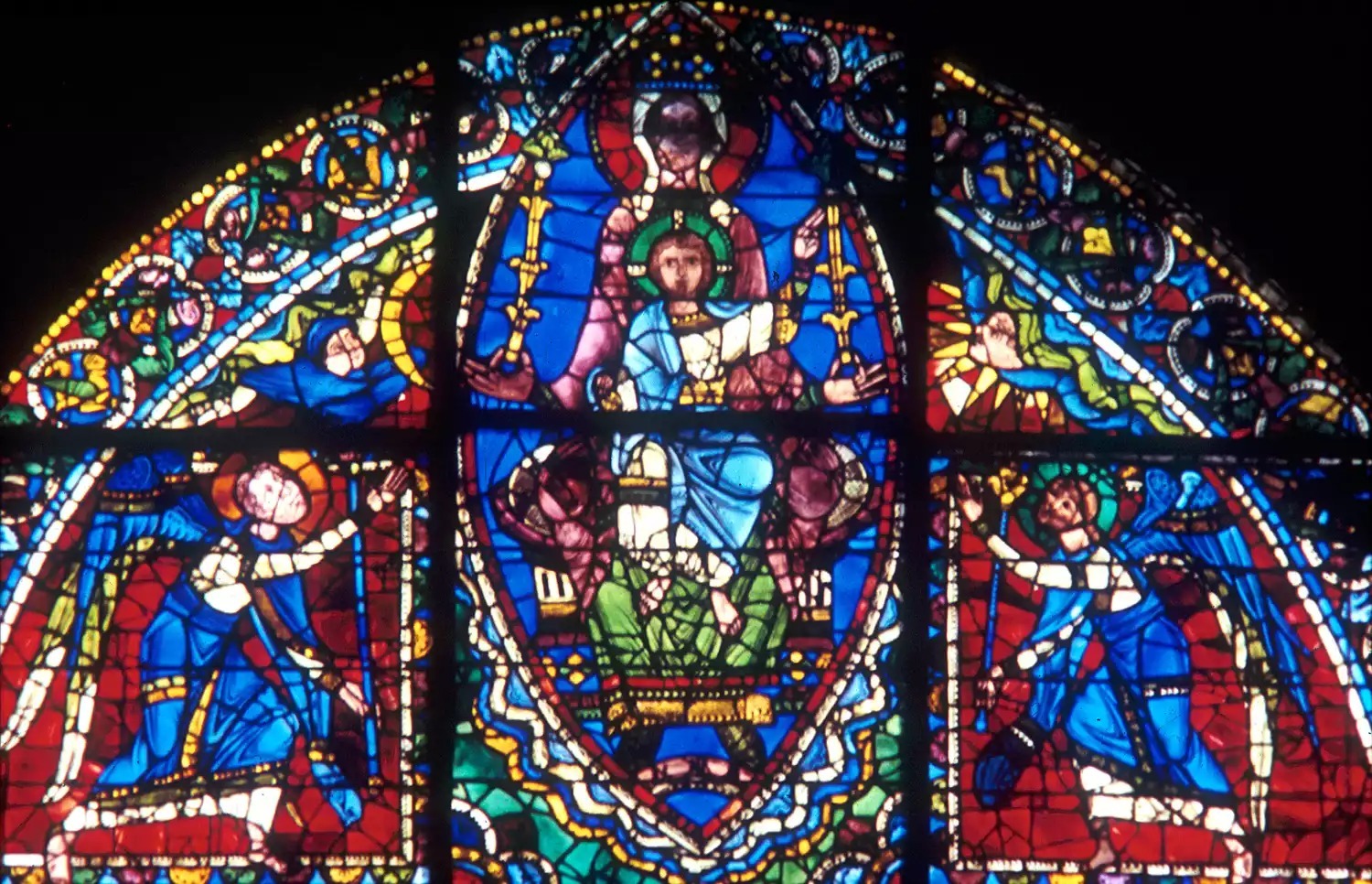
Stained glass windows are a deliberately dynamic art. Set into panels on exterior walls, the different colors of glass react to the sun by glowing brightly. Then, colored light spills out from the frames and onto the floor and other interior objects in shimmering, dappled pools that shift with the sun. Those characteristics attracted the artists of the Medieval period.
Recumbent stone sarcophagi of French kings Philip VI (1293–1350) and John II (1319–1364) dappled in stain glass light. Saint Denis Basilica, Paris. RIEGER Bertrand / hemis.fr / Getty Images Plus
History of Stained Glass Windows
Glass-making was invented in Egypt about 3000 BCE—basically, glass is super-heated sand. Interest in making glass in different colors dates to about the same period. Blue in particular was a prized color in Bronze Age Mediterranean trade in ingot glass.
Putting shaped panes of differently colored glass into a framed window was first used in early Christian churches during the second or third century CE—no examples exist but there are mentions in historical documents. The art may well have been an outgrowth of Roman mosaics, designed floors in elite Roman houses that were made up of squares pieces of rock of different colors. Glass fragments were used to make wall mosaics, such as the famous mosaic at Pompeii of Alexander the Great, which was made primarily of glass fragments. There are early Christian mosaics dated to the 4th century BCE in several places throughout the Mediterranean region.
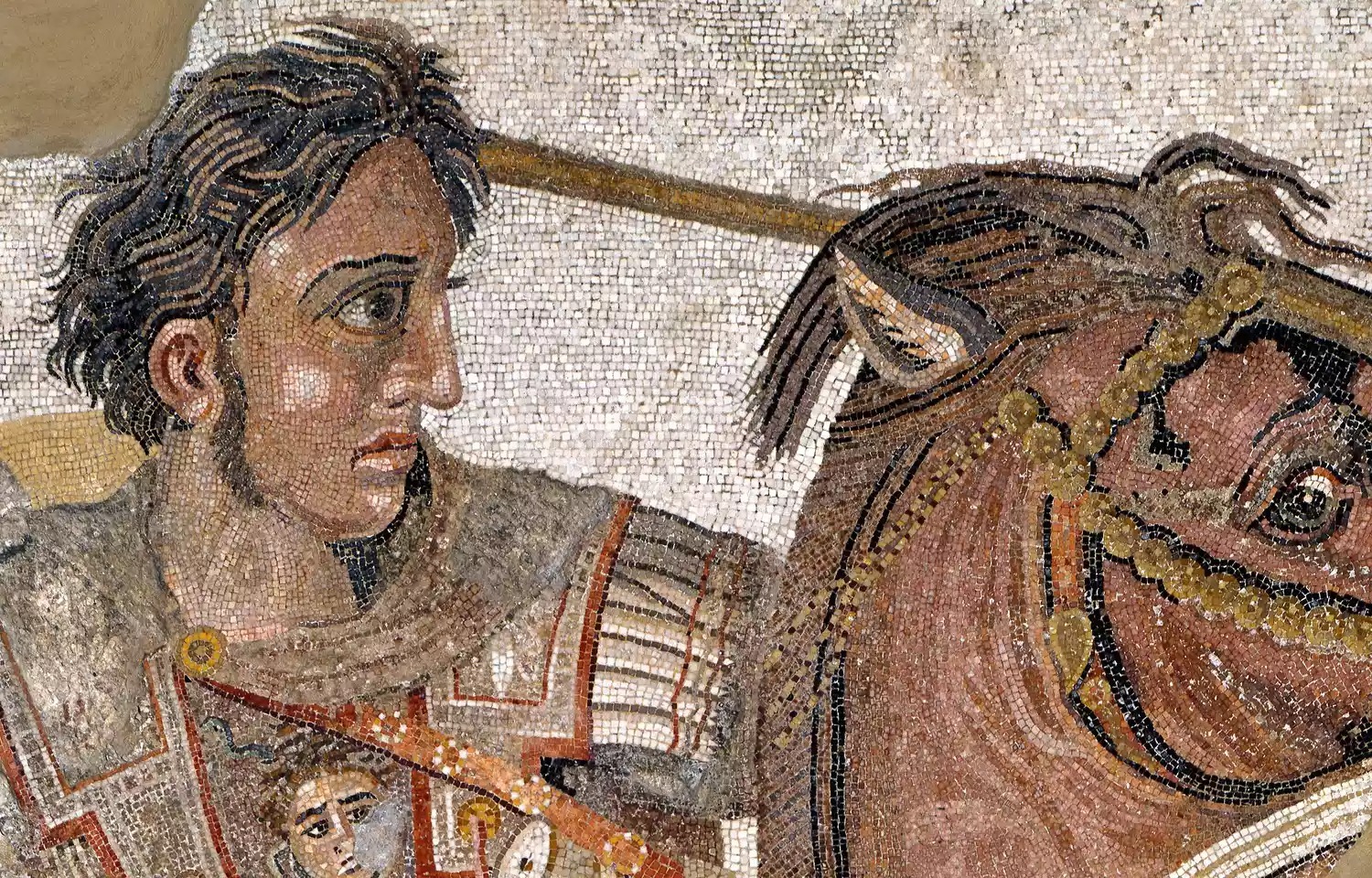
Detail of Mosaic Alexander the Great at the Battle of Issus, Pompeii. Getty Images / Leemage/Corbis
By the 7th century, stained glass was used in churches throughout Europe. Stained glass also owes a great deal to the rich tradition of illuminated manuscripts, handmade books of Christian scripture or practices, made in Western Europe between about 500–1600 CE, and often decorated in richly colored inks and gold leaf. Some of the 13th century stained glass works were copies of illuminated fables.
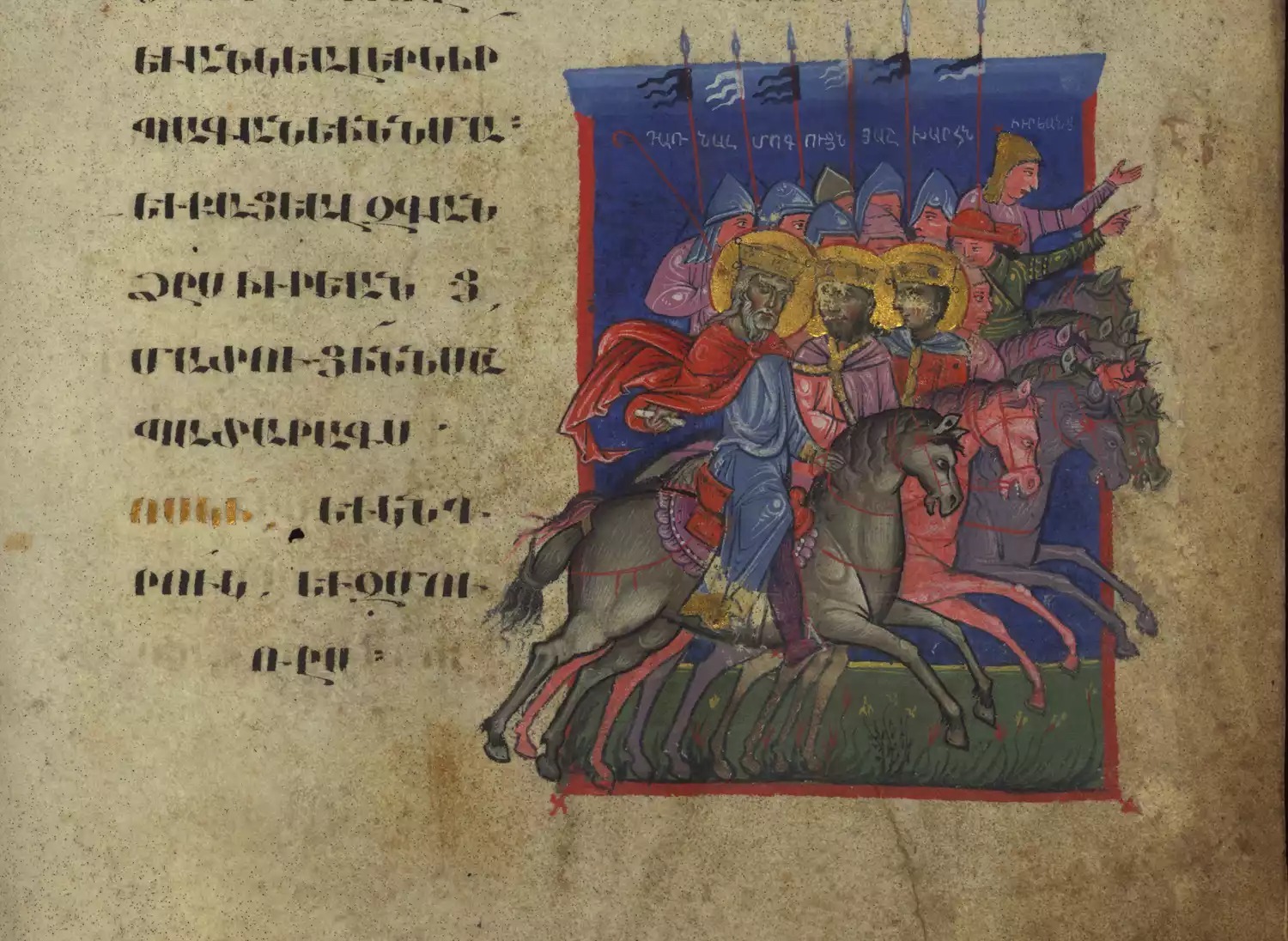
Illustrated manuscript miniature from the Toros Roslin Gospels, 1262. Walters Art Museum, Baltimore. Fine Art Images / Heritage Images / Getty Images
How to Make Stained Glass
The process of making glass is described in a few existing 12th-century texts, and modern scholars and restorers have been using those methods to replicate the process since the early 19th century.
To make a stained glass window, the artist makes a full-sized sketch or “cartoon” of the image. The glass is prepared by combining sand and potash and firing it at temperatures between 2,500–3,000°F. While still molten, the artist adds a small amount of one or more metallic oxides. Glass is naturally green, and to get clear glass, you need an additive. Some of the main mixtures were:
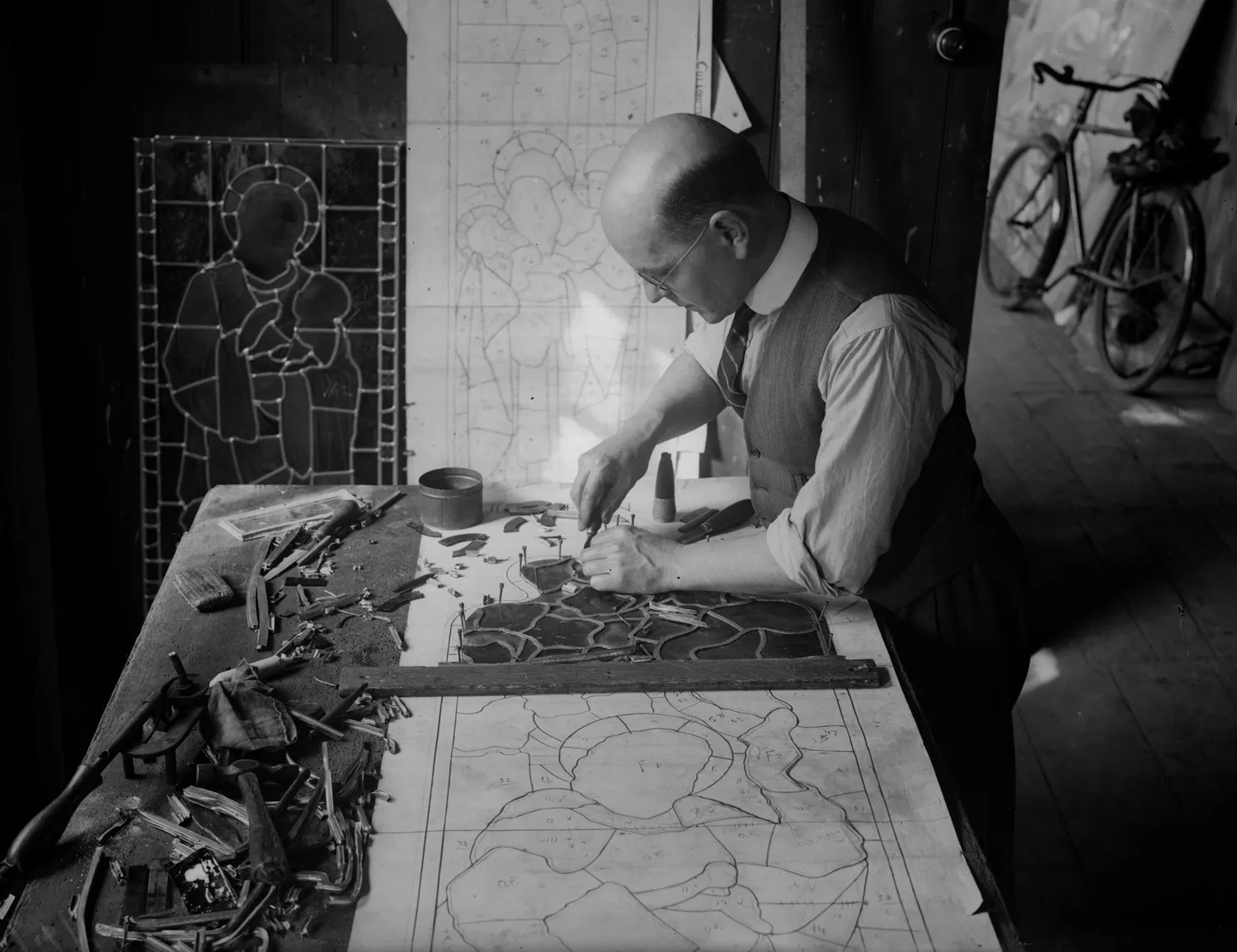
Clear: manganese
Green or blue-green: copper
Deep blue: cobalt
Wine-red or violet: gold
Pale yellow to deep orange or gold: silver nitrate (called silver stain)
Grassy green: combination of cobalt and silver stain
The stained glass is then poured into flat sheets and allowed to cool. Once cooled, the artisan lays the pieces onto the cartoon and cracks the glass in rough approximations of the shape using a hot iron. The rough edges are refined (called “grozing”) by using an iron tool to chip away the excess glass until the precise shape for the composition is produced.
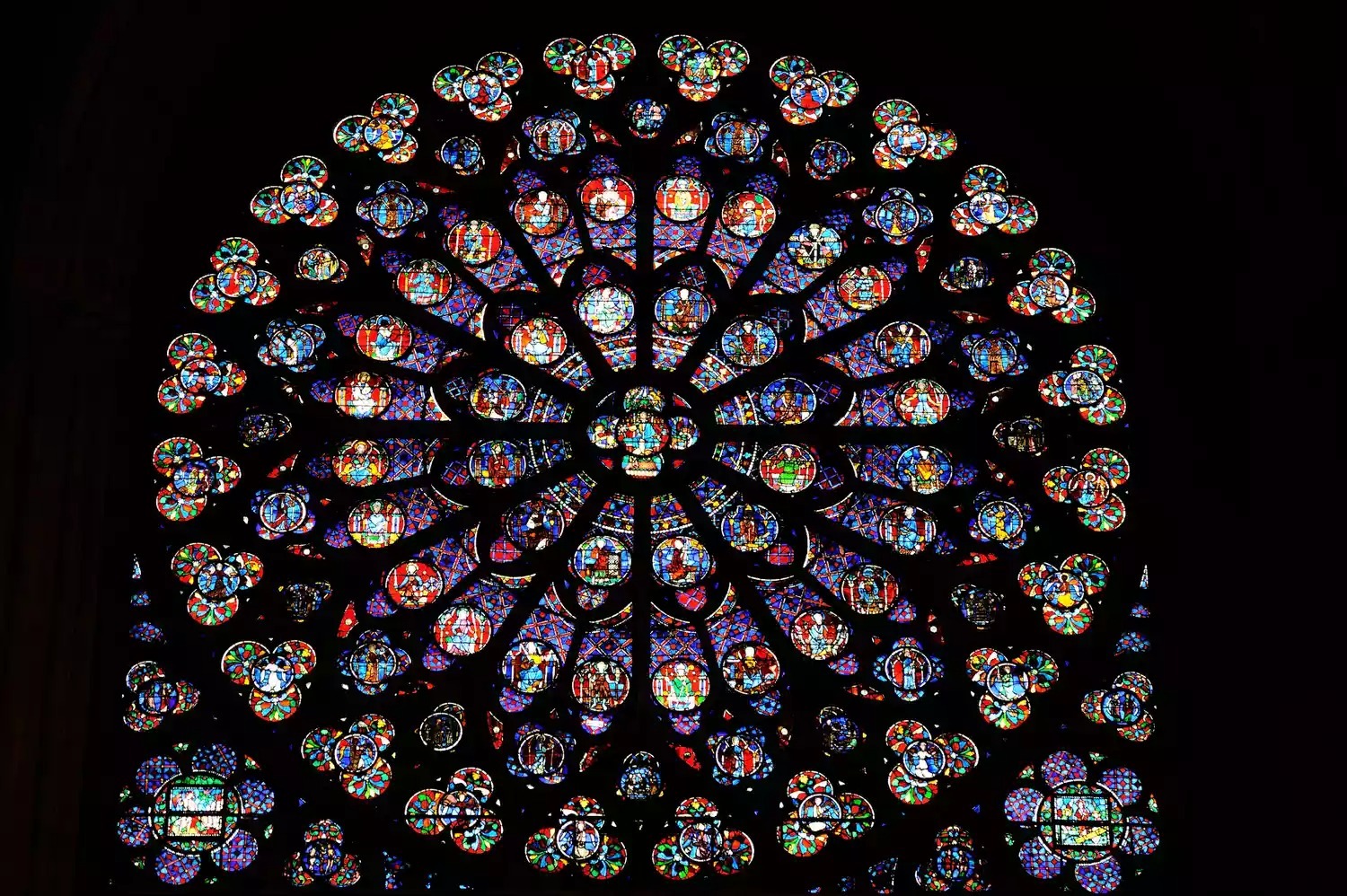
Making a stained glass window at the Morris Co of Merton Abbey (1931). Fox Photos / Stringer / Hulton Archive / Getty Images
Next, the edges of each of the panes are covered with “cames,” strips of lead with an H-shaped cross-section; and the cames are soldered together into a panel. Once the panel is complete, the artist inserts putty between the glass and cames to aid in waterproofing. The process can take from a few weeks to many months, depending on the complexity.
Gothic Window Shapes
The most common window shapes in Gothic architecture are tall, spear-shaped “lancet” windows and circular “rose” windows. Rose or wheel windows are created in a circular pattern with panels that radiate outwards. The largest rose window is at Notre Dame Cathedral in Paris, a massive panel measuring 43 ft in diameter with 84 glass panes that radiate outward from a central medallion.
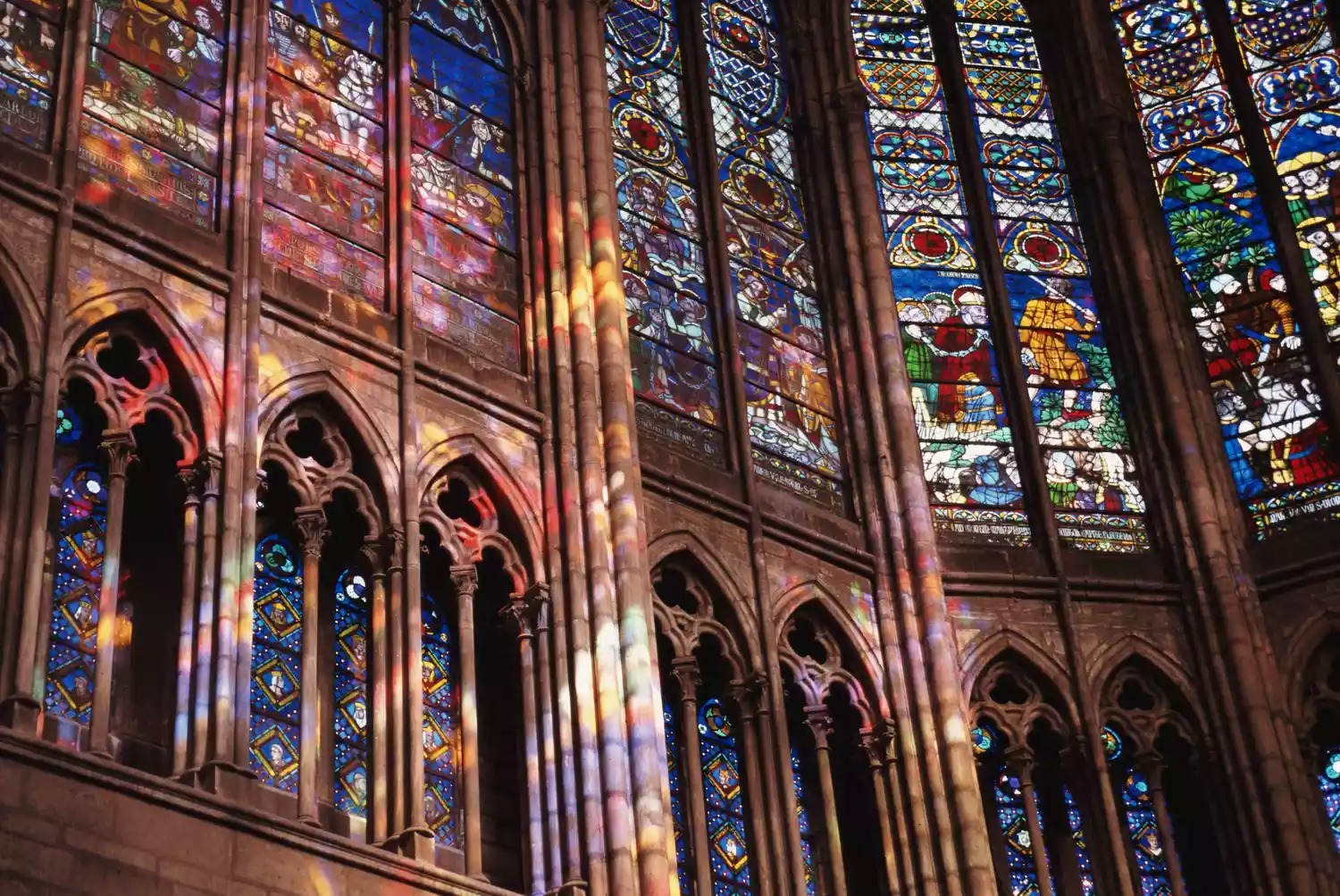
The largest stained glass rose window is at the Catholic cathedral Notre Dame de Paris, on the edges of the Seine in Paris, France. Frédéric Soltan / Corbis / Getty Images
Medieval Cathedrals
The heyday of stained glass occurred in the European Middle Ages, when guilds of craftsmen produced stained glass windows for churches, monasteries, and elite households. The blossoming of the art in medieval churches is attributed to the efforts of Abbot Suger (ca. 1081–1151), a French abbot at Saint-Denis, now best known as the place where French kings were buried.
About 1137, Abbot Suger began to rebuild the church at Saint-Denis–it had been first built in the 8th century and was sorely in need of reconstruction. His earliest panel was a large wheel or rose window, made in 1137, in the choir (eastern part of the church where the singers stand, sometimes called the chancel). The St. Denis glass is remarkable for its use of blue, a deep sapphire that was paid for by a generous donor. Five windows dated to the 12th century remain, although most of the glass has been replaced.
The diaphanous sapphire blue of Abbot Suger was used in various elements of the scenes, but most significantly, it was used in backgrounds. Prior to the abbot’s innovation, backgrounds were clear, white, or a rainbow of colors. Art historian Meredith Lillich comments that for Medieval clergy, blue was next to black in the color palette, and deep blue contrasts God the “father of lights” as super-light with the rest of us in “divine gloom,” eternal darkness and eternal ignorance.
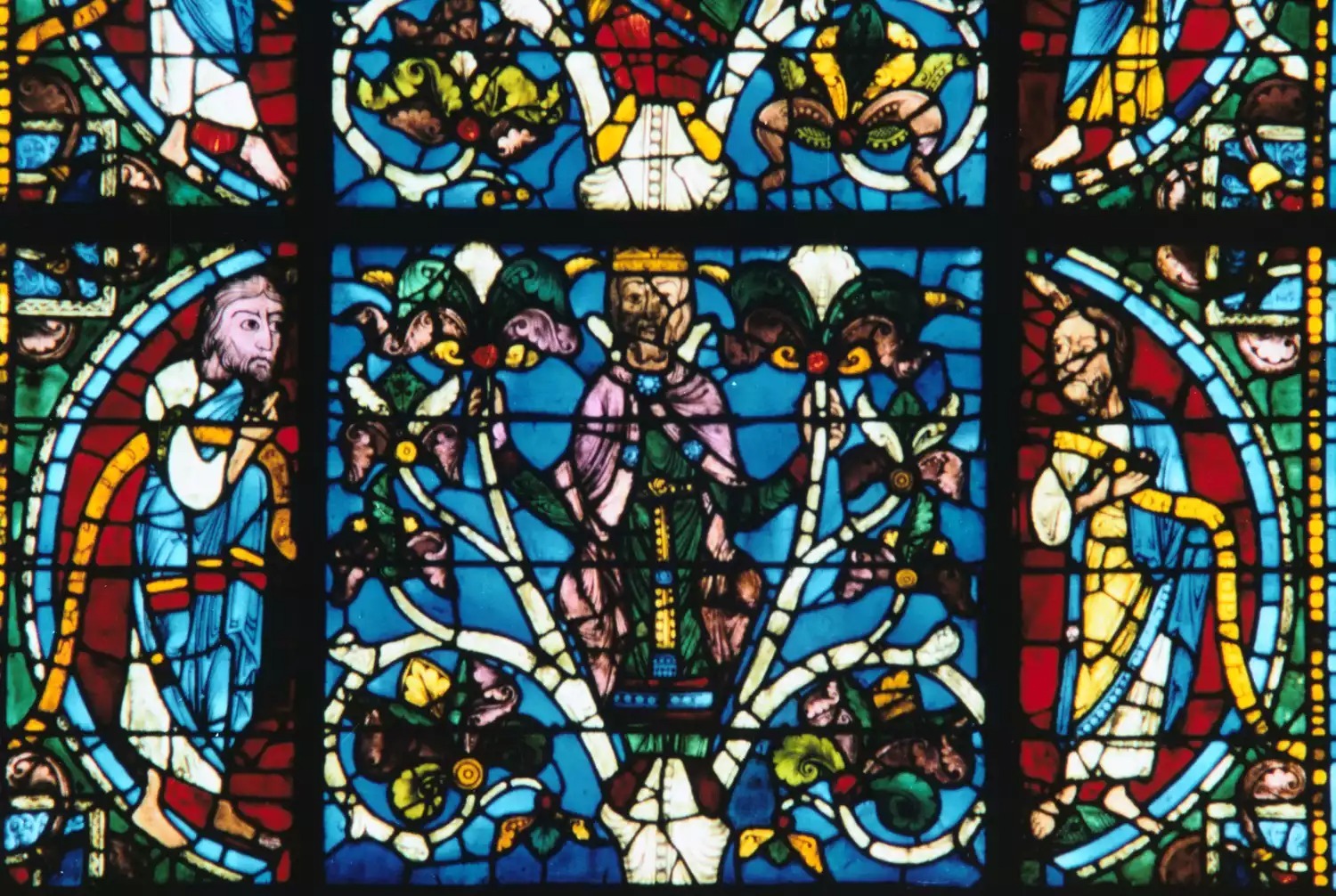
Stained glass windows in Saint-Denis Cathedral, Paris, France
Stained glass windows in Saint-Denis Cathedral, Paris, France. Greg Christensen / Photographer’s Choice / Getty Images Plus
Medieval Meaning
Gothic cathedrals were transformed into a vision of heaven, a place of retreat from the noise of the city. The portrayed images were mostly of certain New Testament parables, especially the prodigal son and the good Samaritan, and of events in the life of Moses or Jesus. One common theme was the “Jesse Tree,” a genealogical form that connected Jesus as descended from the Old Testament King David.
Detail of Jesse Tree from Chartres Cathedral, 1145–1155
Stained glass window of King Solomon flanked by the prophets Isaiah and Micah. Detail from the Jesse Tree Window at Chartres Cathedral, France (1145–1155). Art Media / Print Collector / Getty Images
Abbot Suger began to incorporate stained glass windows because he thought they created a “heavenly light” representing the presence of God. The attraction to the lightness in a church called for taller ceilings and larger windows: it has been argued that architects attempting to put larger windows into cathedral walls in part invented the flying buttress for that purpose. Certainly moving heavy architectural support to the exterior of the buildings opened up cathedral walls to larger window space.
Cistercian Stained Glass (Grisailles)
In the 12th century, the same stained glass images made by the same workers could be found in churches, as well as monastic and secular buildings. By the 13th century, however, the most luxurious were restricted to cathedrals.
The divide between monasteries and cathedrals was primarily of topics and style of stained glass, and that arose because of a theological dispute. Bernard of Clairvaux (known as St. Bernard, ca. 1090–1153) was a French abbot who founded the Cistercian order, a monastic offshoot of the Benedictines that was particularly critical of luxurious representations of holy images in monasteries. (Bernard is also known as the supporter of the Knights Templar, the fighting force of the Crusades.)
In his 1125 “Apologia ad Guillelmum Sancti Theoderici Abbatem” (Apology to William of St. Thierry), Bernard attacked artistic luxury, saying that what may be “excusable” in a cathedral is not appropriate to a monastery, whether cloister or church. He probably wasn’t referring particularly to stained glass: the art form didn’t become popular until after 1137. Nonetheless, the Cistercians believed that using color in images of religious figures was heretical—and Cistercian stained glass was always clear or gray (“grisaille”). Cistercian windows are complex and interesting even without the color.
Nave of the Kloster Eberbach (Eberbach Abbey), in Eltville am Rhein
Eberbach Abbey is a former Cistercian monastery near Eltville am Rhein in the Rheingau, Germany, founded in 1136 by Bernard of Clairvaux as the first Cistercian monastery on the east bank of the Rhine. Ventura Carmona / Moment Unreleased / Getty Images
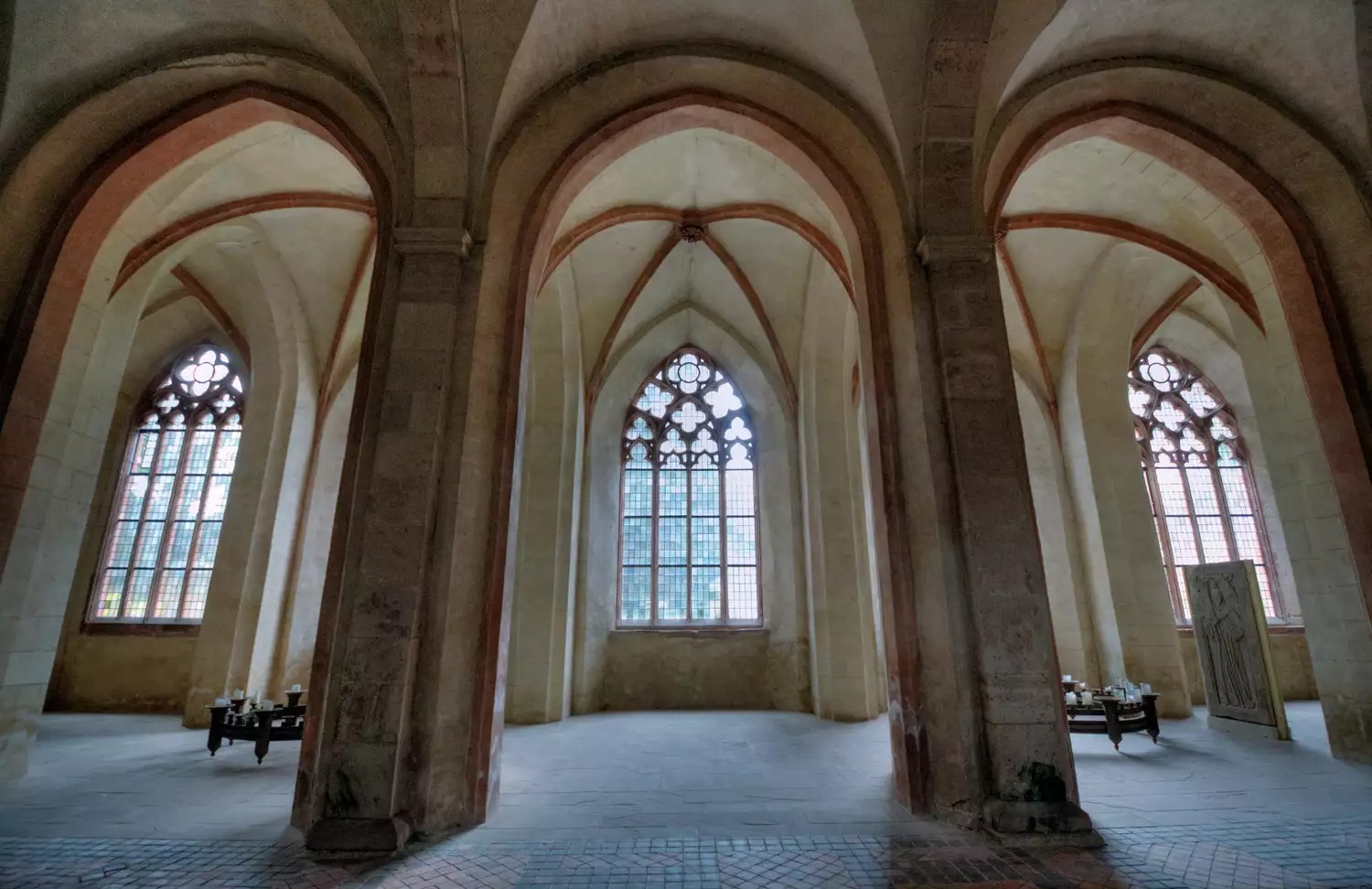
Gothic Revival and Beyond
The heyday of the medieval period stained glass ended about 1600, and after that it became a minor decorative or pictorial accent in architecture, with some exceptions. Beginning in the early 19th century, the Gothic Revival brought old stained glass to the attention of private collectors and museums, who sought restorers. Many small parish churches obtained medieval glasses—for example, between 1804–1811, the cathedral of Lichfield, England, obtained a vast collection of early 16th century panels from the Cistercian convent of Herkenrode.
In 1839, the Passion window of the church of St. Germain l’Auxerrois in Paris was created, a meticulously researched and executed modern window incorporating medieval style. Other artists followed, developing what they considered a rebirth of a cherished art form, and sometimes incorporating fragments of old windows as part of the principle of harmony practiced by Gothic revivalists.
Stained glass window, St. Germain l’Auxerrois church, Paris, France

Gothic Revival stained glass window depicting the Baptism of Jesus by John the Baptist, St. Germain l’Auxerrois church, Paris, France. Godong / robertharding / Getty Images Plus
Through the latter part of the 19th century, artists continued to follow a penchant for earlier medieval styles and subjects. With the art deco movement at the turn of the 20th century, artists such as Jacques Grüber were unleashed, creating masterpieces of secular glasses, a practice that still continues today.
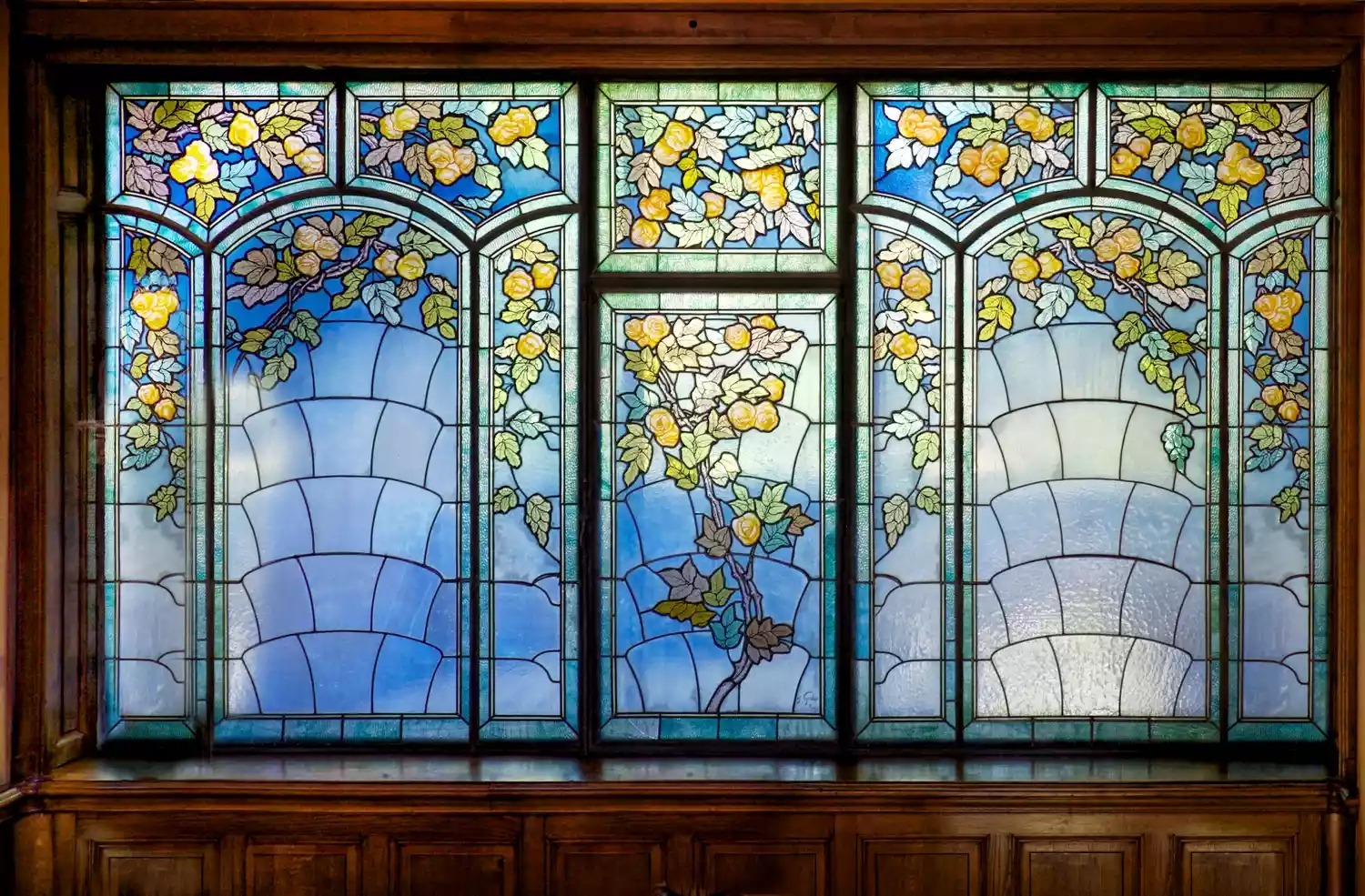
Stained glass window by Jacques Grüber “Les Roses,” 1906.
Stained glass window by Jacques Grüber “Les Roses,” 1906. Musee de l´Ecole de Nancy, Art Nouveau museum, Nancy, France. Alan John Ainsworth / Heritage Images / Getty Images

Leave a Reply